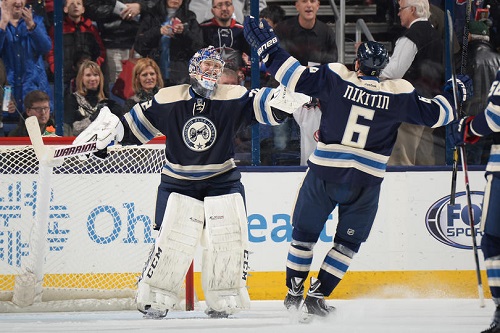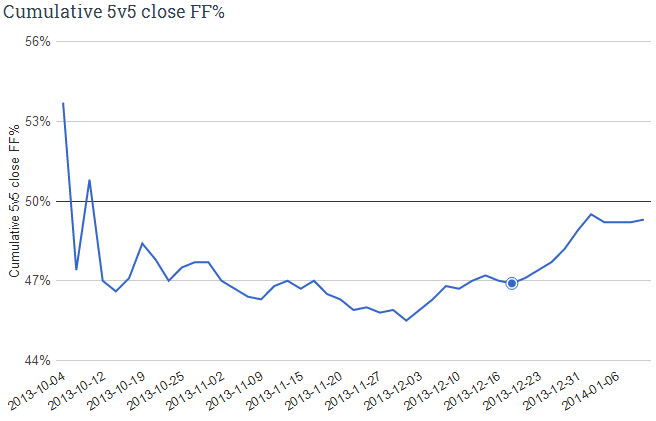Unlikely Headline: The Metropolitan Division is a Very Good Division, and the Blue Jackets are a Very Good Team

The season is heating up at the halfway point and there are some interesting narratives being developed around the league. Such is the case with the Toronto Maple Leafs, who are beginning to realize that their bad possession numbers are more significant than a high save percentage and shooting percentage in their formula to winning. The Philadelphia Flyers have one of the best penalty killing units in the past 6 seasons. The Winnipeg Jets finally decided that three seasons worth of mediocrity was enough. Then there is also the entire Metropolitan Division, which has been the hottest division in the NHL since January 1st.
Yes, that last statement is very true. Since the beginning of 2014, the Metropolitan Division has had the best record in the league going 29-11-6. In fact, the Eastern Conference has gone 50-26-10 while the Western Conference is 35-39-10 since the beginning of the year. Even the New York Islanders, who are last place in the Metropolitan Division, have won four games in a row, and are only seven points away from a playoff berth.
The Blue Jackets have also picked up the pace winning four in a row as well and going 12-6-1 since the beginning of December. This run has moved them to within 2 points of the last playoff spot. Overall, there are 5 teams in the Eastern Conference within 3 points or less of a playoff spot, and it’s entirely reasonable to speculate that the Jackets could be sitting in the 2nd or 3rd-seed within the Metropolitan Division before the Olympic break.
Health
The club was fortunate to lose only one player, Blake Comeau, but net a return of four more players coming off of injuries and onto the starting roster over the past two weeks.
Matt Calvert is an underrated player for the Blue Jackets. If you’re not actively following along with the team in Columbus, it’s possible you know very little, or nothing about him. Calvert brings a high amount of speed and explosiveness to every game he plays. His possession numbers are high and he generates scoring chances. He’s had two lengthy injuries this season, causing him to miss 26 of 46 games. Since his return he’s shared ice time with line-mates Brandon Dubinsky and Cam Atkinson. Calvert only has 8 points in 20 games, but the 24 year-old is poised to have a breakout season any day now.
The player that Ohio wanted to watch was Nathan Horton, who made his first appearance in a Blue Jackets sweater against the Phoenix Coyotes on January 2. He scored a power play goal in his debut. Horton still isn’t completely back into game shape, as the team admitted that his conditioning still needs work, but his presence on the ice has not been a liability. Horton has 2 goals and 2 assists in 6 games with the Blue Jackets, and the team is 5-1-0 with him in the lineup.
These two players have certainly added some scoring potential to the offense, but that hasn’t been the biggest concern for the Blue Jackets recently since they’ve averaged 3.26 goals/game in December and January (league average is 2.76 goals/game). What the Blue Jackets really needed to improve upon was their goaltending, and the Savior of Columbus, Sergei Bobrovsky, has returned from a groin injury after five weeks.
Curtis McElhinney and Mike McKenna were good enough to keep the Blue Jackets competitive throughout Bobrovsky’s injury, but having the reigning Vezina Trophy winner in the lineup makes this team that much more competitive.
In only his second game back, Bobrovsky stopped 36 shots against the divisional rival Carolina Hurricanes to earn his second shutout of the season. It was one of the more uplifting moments of the season as Bobrovsky, with a huge smile, would applaud the home crowd at Nationwide Arena as he left the ice.

Bobrovsky has not been rushed back from his injury. He was cleared to play at the beginning of the year, but he served as back-up for two games before getting a start on January 6. Groin injuries can be very tricky and Bobrovsky was named to Russia’s Olympic team. It’s likely that he’s been a little more cautious than he usually would be, and the team is trying to comply with his ailment and the necessary precautions it can bring. Coming off of a shutout on Friday, Bobrovsky was back-up the next night. That’s not too peculiar but Todd Richards has a tendency to award a goalie with consecutive starts after a shutout.
Marian Gaborik (recovering from a broken collarbone) was also named to Team Slovakia. The Blue Jackets are required to clear Gaborik before he is allowed to play in the Olympics. Meanwhile, Dalton Prout is healthy and played on the 4th-line as a right winger Saturday against Winnipeg, as opposed to playing his traditional position on defence, all in an attempt to give him some ice-time after missing 10 games.
Wealth
Everyone longs for health and wealth in their lifetime, and the Blue Jackets are currently rich in both. The added depth upfront from Horton and Calvert have opposing teams and coaches wondering which line is the top line in Columbus. The truth is, the Blue Jackets have three top lines right now.

The two lines centered by Dubinsky and Johansen are effective at using speed and explosiveness to generate scoring chances, while the line centered by Artem Anisimov is very good at generating scoring chances off of strength play and physicality. Essentially, the team now has the necessary requirements to implement a “bang and strike” style of play, that could be highly effective against most of their opponents.
When one line gets hot, coaches have tried to play their better players against them, but that leaves another two lines the opportunity to get hot. On January 12, Claude Noel even tried putting his best defenceman, Dustin Byfuglien, in a forward position, presumably hoping to generate more offensive depth, but it wasn’t enough. Even though the Blue Jackets were on the tail end of a back-to-back series which caused them to travel to Winnipeg after a game in Columbus the night before, the tired group managed to outplay the Jets and win in commanding fashion, 6-3. The victory for Columbus would be the last game that Claude Noel would coach for Winnipeg.
Boone Jenner is enjoying some of the wealth recently, after he began the season on the first line with Gaborik and Dubinsky. It only lasted for a few minutes before he began getting shuffled around the lineup throughout the season, but lately he’s reaped the most benefits from his new line-mates. Aside from the fact that Jenner’s rookie campaign hasn’t gone as well as Nathan MacKinnon or Chris Kreider’s rookie season, he’s consistently been given ice-time when healthy, and he’s proving to himself that he can compete at this level. He scored 3 goals in the first 2 games that he’s been on a line with Horton and Anisimov, prompting good reason to leave him on that line and increase his ice-time. The 20 year-old has 8 goals and 12 points in 35 games. He’s a proven goal-scorer at the Major Junior level and the Jackets are hoping he can bring that talent with him to the NHL.
Special Teams
There is plenty to be excited about but not everything is perfect with the Blue Jackets. Their penalty kill is ranked 24th, operating at an efficiency of 79.5%. If the Jackets weren’t taking several penalties per game this might not be such a factor, but that’s not the case. They’re averaging 11.7 penalty minutes per game, which is 22nd overall in the league (or 9th worst). Goaltending was an issue when Bobrovsky was out of the lineup, but giving up multiple power play goals in several games will also cost any team points in the standings.
Obviously, the easiest and most effective solution to this problem is to focus on discipline and not take so many penalties, but the Blue Jackets haven’t seemed to worry about that. It’s the one major flaw in their gameplan that could cost them in the long run.
Todd Richards voiced frustration with the Blue Jackets power play after he ended practice on Monday before the game against the Tampa Bay Lightning. The Blue Jackets converted 2 out of 6 power play opportunities Monday night, but through the previous 17 games they’ve only converted 5 out of 53 (9.4%).
Goal Differentials and Shooting Metrics
A good team does one thing really well, score more goals than the other team. It’s a secret to success that most teams try to accomplish every game. Through the months of December and January the Blue Jackets have a goal differential of +11. On the season they’re -2, but that’s good for 3rd best in the Metropolitan Division and 6th best in the Eastern Conference. Basically, it’s not good, but it’s not necessarily awful either.
If you’ve followed along with my last few posts, you’ll know that Corsi is a statistic used to show how many total shot attempts are being taken, rather than how many shots were just put on net. It’s a good statistic to use because it can show us which teams and players are driving possession, and these possession numbers have shown a tendency to correlate with a team’s overall success.
CorsiClose% for all Eastern Conference teams, from game twenty-one forward: pic.twitter.com/n7pFTZsIPt
— Travis Yost (@TravisHeHateMe) January 6, 2014
CorsiClose% is representing the total shot attempts for in situations where the game is within one goal during the first two periods and tied in the third. Remarkably, the Blue Jackets have been a better possession team between games 21-40 than they were in the beginning of the season. This all goes hand-in-hand with their recent record (12-6-1).
On the flip side of this equation is the tail-spinning Maple Leafs, with the worst Corsi numbers in the Eastern Conference.

As you can see above, this is a chart that is illustrating a rolling cumulative Fenwick% for Columbus over the entire season. Fenwick is a statistic that represents a team’s missed shots + shots on goal.
I think it’s a good idea to take a moment to look at the team’s performance on the season, and focus in on the recent upswing.
The lowest point on the chart was the last game of November. The Jackets were 45.5% on the season at that point, which was rock-bottom in the league. The point marked on the graph is from the game against the Philadelphia Flyers on December 19. The Blue Jackets blew a 3-0 lead going into the third period as they allowed the Flyers to score 5 goals in one period. It was one of the worst meltdowns in team history, but it was a lesson learned. Having that game in their rear-view mirror has caused the Jackets to compete harder through 60 minutes in every game since, and the effort has paid off.
They’re leveling off at the 49% mark, but if they continue to keep playing the same as they have been, it won’t be long before this chart is indicating a high FF% on the season, which would be anything above 50%.
The Time is Now
The expectations for the Blue Jackets include a top-3 position within the Metropolitan Division before the Olympic break, flat out. Those are huge expectations but the fans understand this to be true, whether they are willing to admit it or not. Let’s not skim over the fact that they have everything in place to make a run, including a soft schedule, a healthy lineup and a good possession game. Oh yeah, we probably shouldn’t forget that they have a total of three 1st-lines and the reigning Vezina winner at their disposal.


